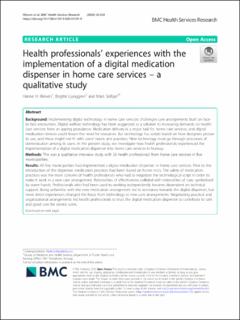Health professionals’ experiences with the implementation of a digital medication dispenser in home care services – a qualitative study.
Peer reviewed, Journal article
Published version
Permanent lenke
https://hdl.handle.net/11250/2739013Utgivelsesdato
2020Metadata
Vis full innførselSamlinger
- Artikler (Articles) [173]
- Publikasjoner fra Cristin - DMMH [138]
Originalversjon
BMC Health Services Research, 2020, 20:320, 1-11. https://doi.org/10.1186/s12913-020-05191-9Sammendrag
Background: Implementing digital technology in home care services challenges care arrangements built on faceto-face encounters. Digital welfare technology has been suggested as a solution to increasing demands on health care services from an ageing population. Medication delivery is a major task for home care services, and digital medication devices could lessen the need for resources. But technology has scripts based on how designers picture its use, and these might not fit with users’ needs and practices. New technology must go through processes of domestication among its users. In the present study, we investigate how health professionals experienced the implementation of a digital medication dispenser into home care services in Norway. Methods: This was a qualitative interview study with 26 health professionals from home care services in five municipalities. Results: All five municipalities had implemented a digital medication dispenser in home care services. Prior to the introduction of the dispenser, medication practices had been based on home visits. The safety of medication practices was the main concern of health professionals who had to negotiate the technological script in order to make it work in a new care arrangement. Rationalities of effectiveness collided with rationalities of care, symbolized by warm hands. Professionals who had been used to working independently became dependent on technical support. Being unfamiliar with the new medication arrangement led to resistance towards the digital dispenser, but more direct experiences changed the focus from technology to new care arrangements. Negotiating practical and organizational arrangements led health professionals to trust the digital medication dispenser to contribute to safe and good care for service users. Conclusions: Implementing digital technology in home care services must be informed by previous practices in the field, especially when it concerns safety for patients. Through processes of domestication, health professionals negotiate technological scripts to make them fit professional ideals and practices. Policymakers and managers must address questions of care arrangements and individualized adaptions to patients’ needs in order to receive support from health professionals when implementing digital technology in home care services.

